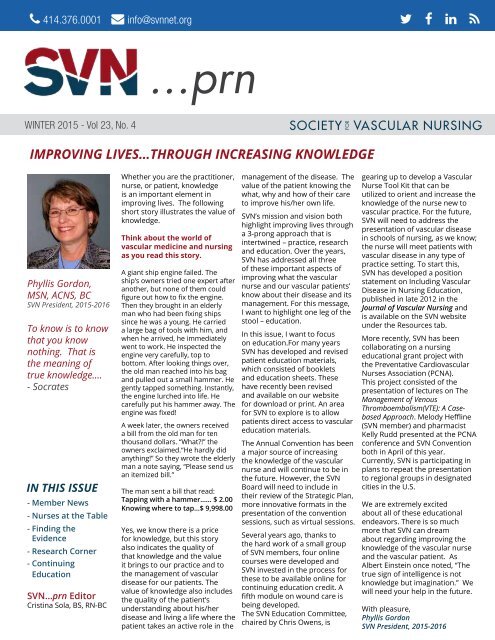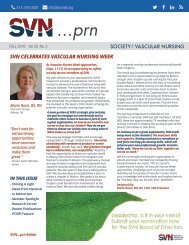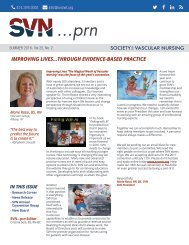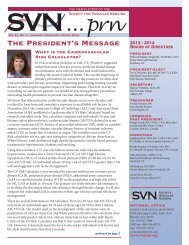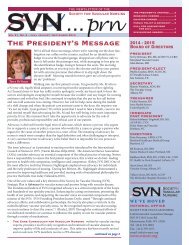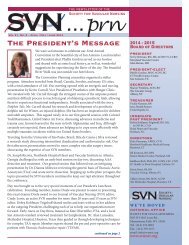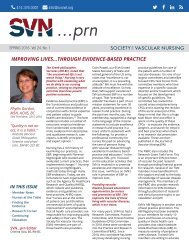SVN...prn Winter 2015 Issue
Create successful ePaper yourself
Turn your PDF publications into a flip-book with our unique Google optimized e-Paper software.
414.376.0001 info@svnnet.org<br />
<br />
...<strong>prn</strong><br />
WINTER <strong>2015</strong> - Vol 23, No. 4<br />
IMPROVING LIVES…THROUGH INCREASING KNOWLEDGE<br />
Phyllis Gordon,<br />
MSN, ACNS, BC<br />
<strong>SVN</strong> President, <strong>2015</strong>-2016<br />
To know is to know<br />
that you know<br />
nothing. That is<br />
the meaning of<br />
true knowledge….<br />
- Socrates<br />
IN THIS ISSUE<br />
- Member News<br />
- Nurses at the Table<br />
- Finding the<br />
Evidence<br />
- Research Corner<br />
- Continuing<br />
Education<br />
<strong>SVN</strong>...<strong>prn</strong> Editor<br />
Cristina Sola, BS, RN-BC<br />
Whether you are the practitioner,<br />
nurse, or patient, knowledge<br />
is an important element in<br />
improving lives. The following<br />
short story illustrates the value of<br />
knowledge.<br />
Think about the world of<br />
vascular medicine and nursing<br />
as you read this story.<br />
A giant ship engine failed. The<br />
ship’s owners tried one expert after<br />
another, but none of them could<br />
figure out how to fix the engine.<br />
Then they brought in an elderly<br />
man who had been fixing ships<br />
since he was a young. He carried<br />
a large bag of tools with him, and<br />
when he arrived, he immediately<br />
went to work. He inspected the<br />
engine very carefully, top to<br />
bottom. After looking things over,<br />
the old man reached into his bag<br />
and pulled out a small hammer. He<br />
gently tapped something. Instantly,<br />
the engine lurched into life. He<br />
carefully put his hammer away. The<br />
engine was fixed!<br />
A week later, the owners received<br />
a bill from the old man for ten<br />
thousand dollars. “What?!” the<br />
owners exclaimed.“He hardly did<br />
anything!” So they wrote the elderly<br />
man a note saying, “Please send us<br />
an itemized bill.”<br />
The man sent a bill that read:<br />
Tapping with a hammer…… $ 2.00<br />
Knowing where to tap…$ 9,998.00<br />
Yes, we know there is a price<br />
for knowledge, but this story<br />
also indicates the quality of<br />
that knowledge and the value<br />
it brings to our practice and to<br />
the management of vascular<br />
disease for our patients. The<br />
value of knowledge also includes<br />
the quality of the patient’s<br />
understanding about his/her<br />
disease and living a life where the<br />
patient takes an active role in the<br />
management of the disease. The<br />
value of the patient knowing the<br />
what, why and how of their care<br />
to improve his/her own life.<br />
<strong>SVN</strong>’s mission and vision both<br />
highlight improving lives through<br />
a 3-prong approach that is<br />
intertwined – practice, research<br />
and education. Over the years,<br />
<strong>SVN</strong> has addressed all three<br />
of these important aspects of<br />
improving what the vascular<br />
nurse and our vascular patients’<br />
know about their disease and its<br />
management. For this message,<br />
I want to highlight one leg of the<br />
stool – education.<br />
In this issue, I want to focus<br />
on education.For many years<br />
<strong>SVN</strong> has developed and revised<br />
patient education materials,<br />
which consisted of booklets<br />
and education sheets. These<br />
have recently been revised<br />
and available on our website<br />
for download or print. An area<br />
for <strong>SVN</strong> to explore is to allow<br />
patients direct access to vascular<br />
education materials.<br />
The Annual Convention has been<br />
a major source of increasing<br />
the knowledge of the vascular<br />
nurse and will continue to be in<br />
the future. However, the <strong>SVN</strong><br />
Board will need to include in<br />
their review of the Strategic Plan,<br />
more innovative formats in the<br />
presentation of the convention<br />
sessions, such as virtual sessions.<br />
Several years ago, thanks to<br />
the hard work of a small group<br />
of <strong>SVN</strong> members, four online<br />
courses were developed and<br />
<strong>SVN</strong> invested in the process for<br />
these to be available online for<br />
continuing education credit. A<br />
fifth module on wound care is<br />
being developed.<br />
The <strong>SVN</strong> Education Committee,<br />
chaired by Chris Owens, is<br />
gearing up to develop a Vascular<br />
Nurse Tool Kit that can be<br />
utilized to orient and increase the<br />
knowledge of the nurse new to<br />
vascular practice. For the future,<br />
<strong>SVN</strong> will need to address the<br />
presentation of vascular disease<br />
in schools of nursing, as we know;<br />
the nurse will meet patients with<br />
vascular disease in any type of<br />
practice setting. To start this,<br />
<strong>SVN</strong> has developed a position<br />
statement on Including Vascular<br />
Disease in Nursing Education,<br />
published in late 2012 in the<br />
Journal of Vascular Nursing and<br />
is available on the <strong>SVN</strong> website<br />
under the Resources tab.<br />
More recently, <strong>SVN</strong> has been<br />
collaborating on a nursing<br />
educational grant project with<br />
the Preventative Cardiovascular<br />
Nurses Association (PCNA).<br />
This project consisted of the<br />
presentation of lectures on The<br />
Management of Venous<br />
Thromboembolism(VTE): A Casebased<br />
Approach. Melody Heffline<br />
(<strong>SVN</strong> member) and pharmacist<br />
Kelly Rudd presented at the PCNA<br />
conference and <strong>SVN</strong> Convention<br />
both in April of this year.<br />
Currently, <strong>SVN</strong> is participating in<br />
plans to repeat the presentation<br />
to regional groups in designated<br />
cities in the U.S.<br />
We are extremely excited<br />
about all of these educational<br />
endeavors. There is so much<br />
more that <strong>SVN</strong> can dream<br />
about regarding improving the<br />
knowledge of the vascular nurse<br />
and the vascular patient. As<br />
Albert Einstein once noted, “The<br />
true sign of intelligence is not<br />
knowledge but imagination.” We<br />
will need your help in the future.<br />
With pleasure,<br />
Phyllis Gordon<br />
<strong>SVN</strong> President, <strong>2015</strong>-2016
MEMBER news<br />
SAYING GOODBYE<br />
M. Isobel Green, RN, CNS,<br />
CNC, CVN past <strong>SVN</strong> Treasurer<br />
and longtime member<br />
recently passed away.<br />
Green worked tirelessly to<br />
promote vascular nursing and<br />
is described consistently as the<br />
kindest person who was a pure<br />
joy to work with and a tireless<br />
promote of <strong>SVN</strong>.<br />
Her <strong>SVN</strong> colleagues have these<br />
memories to share:<br />
“When I first came onto the<br />
board, Isobel was the treasurer,<br />
and I had the honor of sharing<br />
a room with her on occasion. She<br />
is from England and would travel<br />
with one small carry-on for the<br />
whole week. She taught me to<br />
pack by rolling my clothes. I still<br />
tell that story. “<br />
- Phyllis Gordon<br />
“Isobel was a wonderful kind<br />
and compassionate person who<br />
worked very hard in promoting<br />
<strong>SVN</strong> and vascular nursing<br />
internationally. A big loss to<br />
the vascular nursing world!”<br />
- Marge Lovell<br />
“Isobel was very passionate<br />
about vascular nursing and<br />
such a wonderful mentor. She<br />
will be so missed.”<br />
- Debra Kohlman-Trigoboff<br />
“She was truly a great person.<br />
Isobel served as treasurer when<br />
I was president and was a pure<br />
joy to work with and get to know<br />
as a friend. She was a tireless<br />
promoter of <strong>SVN</strong>. We will all<br />
miss her.”<br />
- Jane Frasca<br />
“So saddened to hear of<br />
Isobel’s passing. She was one<br />
of the kindest people I had the<br />
pleasure of knowing.”<br />
- Karen Fitzgerald<br />
Share your favorite memory<br />
of Isobel with us on the <strong>SVN</strong><br />
Facebook page.<br />
NEW BOARD MEMBER<br />
<strong>SVN</strong><br />
welcomes<br />
Chris Owen,<br />
BSN, MSN,<br />
RNFA to the<br />
Board of<br />
Directors.<br />
Owen was appointed to the board<br />
in November to fill a vacated board<br />
position.<br />
Board Profile Director<br />
(<strong>2015</strong>-2017)<br />
Chris Owen, MSN, ACNP-BC, RNFA<br />
Baltimore Washington Medical<br />
Center, Maryland<br />
Liaison to: Education Committee<br />
www.svnnet.org
NURSES at the table<br />
Submitted by<br />
Patty Flanagan MSN, RN-BC<br />
<strong>SVN</strong> Board Liaison to Public Policy &<br />
Advocacy Committee<br />
It is an honor and a privilege for<br />
nurses to advocate for patients<br />
as individuals, families and<br />
communities. Nursing is a highly<br />
respected and trusted profession.<br />
Patients and the public value what<br />
nurses have to say. Nurses bring<br />
to the table real life scenarios to<br />
aid in the discussion of healthcare<br />
issues.<br />
In the day to day care of patients,<br />
nurses are good at advocating for<br />
individual patient needs. However,<br />
patient advocacy goes beyond<br />
that. Being involved in decisions<br />
that impact the nurse’s patient<br />
population is an important aspect<br />
of nursing. Nurses can advocate<br />
for patients by being involved<br />
in decision-making committees<br />
at their place of employment,<br />
whether it be in an inpatient or<br />
outpatient setting.<br />
Nurses can advocate for families<br />
by listening to their concerns and<br />
needs, identifying the common<br />
thread and acting on that need;<br />
targeting the appropriate key<br />
figures to address the issues and<br />
become involved in the decisionmaking<br />
process.<br />
Communities can be geographic<br />
or disease-specific populations.<br />
Advocating for communities<br />
includes becoming involved in<br />
disease-specific organizations,<br />
town boards, zoning boards,<br />
and school boards as well as<br />
monitoring legislation for health<br />
care issues being discussed.<br />
Communicating to key figures<br />
the issues and their impact<br />
on patients, families and<br />
communities.<br />
Nurses also need to be aware of<br />
issues affecting the profession,<br />
being aware of issues being<br />
discussed at the nurse’s place<br />
of employment, nursing<br />
organizations and in legislation.<br />
Nurses must prepare themselves<br />
to take part in the discussions<br />
and place themselves in positions<br />
of influence to advocate for<br />
patients as individuals, families,<br />
communities and the nursing<br />
profession. <br />
References:<br />
1. Burns, N., Grove, S. Understanding nursing research (5th Ed). 2011. Philadelphia: Elsevier Saunders.<br />
2. Song, J., Chung, K. Observational studies: cohort and case-control studies. Plast Reconstr Surg: 2010; 126(6): 2234-2242.<br />
3. Framingham Heart Study. Available at: https://www.framinghamheartstudy.org/<br />
Call for JVN Editorial Board Members<br />
The Journal of Vascular Nursing is soliciting interested colleagues<br />
to apply for an Editorial Board appointment.<br />
Editorial Board members are responsible for editorial review of manuscripts<br />
for publication in JVN and for assisting the Editor as assigned. Service on the<br />
Editorial Board is for one year to be renewed annually at the Editor’s discretion.<br />
Qualifications for appointment consideration include the following:<br />
1. Registered professional nurse. Master’s degree in nursing required.<br />
2. Vascular nursing practice experience in areas of education, practice,<br />
administration, or research sufficient to developing considerable expertise<br />
in the area.<br />
3. Documented writing ability as evidenced by publication.<br />
4. Membership in <strong>SVN</strong> for a minimum of one year.<br />
We invite interested colleagues to submit a letter of interest, including<br />
your fields of interest and expertise, and current curriculum vitae to<br />
the Editor, Cindy Lewis MSN, RN, ACNS-BC, at Cynthia.lewis@aurora.<br />
org. All applications will be reviewed.<br />
www.svnnet.org
Finding the Evidence<br />
“EVIDENCE BASED PRACTICE”<br />
Submitted by<br />
Debra Kohlman-Trigoboff,<br />
RN, MS, ACNP-BO, CVN,<br />
<strong>SVN</strong> Past President<br />
Evidence Based Practice (EBP)<br />
is an approach to patient care<br />
integrating the strongest research<br />
evidence, clinical expertise and<br />
patient preferences 1,2 . Utilizing EPB<br />
is not only about implementing<br />
strong evidence into practice,<br />
but it also entails removing<br />
harmful or ineffective practice<br />
patterns. EPB has been shown to<br />
improve patient outcomes, reduce<br />
healthcare cost and increase<br />
clinician satisfaction 3 .<br />
Keeping current with EBP requires<br />
self-direction and spans the<br />
lifetime of one’s practice. With<br />
busy clinical practice and home<br />
schedules, practitioners often<br />
find it difficult to keep up with<br />
and ultimately implement the EBP<br />
recommendations. One study cites<br />
EBP is used approximately 55% of<br />
the time by medical professionals 4 ;<br />
one barrier being the time<br />
constraints needed to review<br />
and assimilate the data.<br />
There are multiple medical<br />
resources now available online to<br />
keep practitioners up-to-date with<br />
the current literature. Vincent,<br />
et al (<strong>2015</strong>) has compiled a list of<br />
strategies for maintaining currency<br />
in research and clinical literature.<br />
Please refer to Table 1 below.<br />
Table 1 (Vincent, et al <strong>2015</strong>)<br />
www.svnnet.org
Finding the Evidence<br />
“EVIDENCE BASED PRACTICE” continued<br />
Computerized decision models<br />
that assimilate and summarize<br />
relevant research evidence linking<br />
it through the electronic medical<br />
record to a patient’s situation may<br />
be the ultimate way to improve<br />
clinical care. Though this technique<br />
would be ideal, many practices<br />
don’t have access to computerized<br />
decision models. More readily<br />
available, however are many<br />
resources that have already<br />
critically evaluated research<br />
and have compiled a summary<br />
of the critical studies into<br />
single documents. Examples of<br />
assimilated and critically evaluated<br />
research include clinical practice<br />
guidelines, several of which have<br />
been developed by <strong>SVN</strong> members<br />
and can be accessed on the <strong>SVN</strong><br />
website. There are other examples<br />
of pre-appraised evidence listed in<br />
Table 2 by Vincent, et al (<strong>2015</strong>).<br />
Table 2 (Vincent, et al <strong>2015</strong>)<br />
The goal of evidence based<br />
practice is quality improvement<br />
ensuring implementation<br />
of best practices. Many EBP<br />
authors stress the importance of<br />
individualizing the evidence to<br />
the patient and have meaningful<br />
conversations with the patient and<br />
other healthcare professionals.<br />
Though many practitioners may<br />
have busy home and practice<br />
schedules, mastering the plethora<br />
of evidence in the clinical literature<br />
can be achieved through the use<br />
of internet resources and preappraised<br />
clinical evidence to<br />
implement and improve clinical<br />
practice. <br />
References:<br />
1. Sackett, D, Straus, S, Richardson W, et al Evidence Based Medicine: How to Practice and Teach. EBM 2nd ed, Edinburgh, Scotland: Churchill<br />
Livingstone, 2005<br />
2. Straus, S. Evidence-Based Medicine: How to Practice and Teach. EBM. New York, NY. Churchill Livingstone, 2005.<br />
3. Melnyk, B, Fineout-Overbolt, E. Evidence-Based Practice in Nursing and Healthcare. 2nd Ed. Philadelphia: PA: Lippincott Williams & Wilkins,<br />
2011.<br />
4. Institute of Medicine. Crossing the Quality Chasm: A New Health System for the 21st Century. Washington, DC: National Academies Press:<br />
2001.<br />
5. Vincent, D, Hastings-Tolsma, M, Gephart, S, et al. Nurse Practitioner Clinical Decision-Making and Evidence-Based Practice. The Nurse<br />
Practitioner, <strong>2015</strong>, 40(5): 47-54.<br />
www.svnnet.org
RESEARCH<br />
Corner<br />
Barth J, Jacob T, Daha I, et al.<br />
Psychosocial interventions for smoking<br />
cessation in patients<br />
with coronary heart disease.<br />
Cochrane Database Syst<br />
Rev. <strong>2015</strong> Jul 6; 7:CD006886<br />
Benetos A, Rossignol P,<br />
Cherubini A, et al.<br />
Polypharmacy in the Aging Patient:<br />
Management of Hypertension in<br />
Octogenarians.<br />
JAMA. <strong>2015</strong> Jul 14;314(2):170-180<br />
Blyth A, Maskrey V, Notley C, et al.<br />
Effectiveness and economic evaluation<br />
of self-help educational materials for<br />
the prevention of smoking relapse:<br />
randomised controlled trial. Health<br />
Technol Assess. <strong>2015</strong> Jul;19(59):1-70.<br />
Dumville JC, Land L, Evans D, et al.<br />
Negative pressure wound therapy<br />
for treating leg ulcers.<br />
Cochrane Database Syst Rev. <strong>2015</strong> Jul<br />
14;7:CD011354.<br />
Ebbert JO, Elrashidi MY,<br />
Stead LF Interventions for smokeless<br />
tobacco use cessation.<br />
Cochrane Database Syst Rev. <strong>2015</strong> Oct<br />
26;10:CD004306.<br />
Gepner Y, Golan R, Harman-Boehm I,<br />
et al.<br />
Effects of Initiating Moderate Alcohol<br />
Intake on Cardiometabolic Risk in<br />
Adults With Type 2 Diabetes: A 2-Year<br />
Randomized, Controlled Trial.<br />
Ann Intern Med. <strong>2015</strong> Oct 13.<br />
McInnes E, Jammali-Blasi A,<br />
Bell-Syer SE, et al.<br />
Support surfaces for pressure ulcer<br />
prevention.<br />
Cochrane Database Syst Rev. <strong>2015</strong> Sep<br />
3;9:CD001735.<br />
O`Meara S, Martyn-St James M,<br />
Adderley UJ.<br />
Alginate dressings for venous leg<br />
ulcers.<br />
Cochrane Database Syst Rev. <strong>2015</strong> Aug<br />
19;8:CD010182.<br />
Patnode CD, Henderson JT,<br />
Thompson JH, et al.<br />
Behavioral Counseling and<br />
Pharmacotherapy Interventions for<br />
Tobacco Cessation in Adults, Including<br />
Pregnant Women: A Review of Reviews<br />
for the U.S. Preventive Services Task<br />
Force.<br />
Ann Intern Med. <strong>2015</strong> Sep 22.<br />
Pursnani A, Massaro JM, D`Agostino<br />
RB Sr, et al.<br />
Guideline-Based Statin Eligibility,<br />
Coronary Artery Calcification, and<br />
Cardiovascular Events.<br />
JAMA. <strong>2015</strong> Jul 14;314(2):134-41.<br />
Sharma M, Cornelius VR, Patel JP,<br />
et al. Efficacy and Harms of Direct<br />
Oral Anticoagulants in the Elderly for<br />
Stroke Prevention in Atrial Fibrillation<br />
and Secondary Prevention of Venous<br />
Thromboembolism: Systematic Review<br />
and Meta-Analysis.<br />
Circulation. <strong>2015</strong> Jul 21;132(3):194-204.<br />
Smyth RM, Aflaifel N, Bamigboye<br />
AA Interventions for varicose veins<br />
and leg oedema in pregnancy.<br />
Cochrane Database Syst Rev. <strong>2015</strong> Oct<br />
19;10:CD001066.<br />
Stead LF, Koilpillai P, Lancaster T<br />
Additional behavioural support as<br />
an adjunct to pharmacotherapy for<br />
smoking cessation. Cochrane Database<br />
Syst Rev. <strong>2015</strong> Oct 12;10:CD009670.<br />
Umpierrez G, Cardona S, Pasquel F, et<br />
al. Randomized Controlled<br />
Trial of Intensive Versus Conservative<br />
Glucose Control in Patients Undergoing<br />
Coronary Artery Bypass Graft Surgery:<br />
GLUCO-CABG Trial.<br />
Diabetes Care. <strong>2015</strong> Jul 15.<br />
Uthman OA, Hartley L, Rees K, et al.<br />
Multiple risk factor interventions for<br />
primary prevention of cardiovascular<br />
disease in low- and middle-income<br />
countries.<br />
Cochrane Database Syst Rev. <strong>2015</strong> Aug<br />
4;8:CD011163.<br />
Wang D, Liu B, Tao W, et al.<br />
Fibrates for secondary prevention of<br />
cardiovascular disease and stroke.<br />
Cochrane Database Syst Rev. <strong>2015</strong> Oct<br />
25;10:CD009580.<br />
Williams B, MacDonald TM, Morant S,<br />
et al.<br />
Spironolactone versus placebo,<br />
bisoprolol, and doxazosin to determine<br />
the optimal treatment for drugresistant<br />
hypertension (PATHWAY-2): a<br />
randomised, double-blind,<br />
crossover trial.<br />
Lancet. <strong>2015</strong> Sep 18. pii: S0140-<br />
6736(15)00257-3.<br />
Wong GW, Laugerotte A, Wright JM.<br />
Blood pressure lowering efficacy of<br />
dual alpha and beta blockers for<br />
primary hypertension.<br />
Cochrane Database Syst Rev. <strong>2015</strong> Aug<br />
26;8:CD007449.<br />
Wu L, Norman G, Dumville JC, et al.<br />
Dressings for treating foot ulcers in<br />
people with diabetes: an overview of<br />
systematic reviews.<br />
Cochrane Database Syst Rev. <strong>2015</strong> Jul<br />
14;7:CD010471.<br />
Janice D. Nunnelee PhD RN<br />
Practice and Research Committee<br />
414.376.0001 info@svnnet.org
Continuing ED<br />
IAC RESEARCH AWARD PROGRAM:<br />
2016 CALL FOR PROPOSALS<br />
MAYO CLINIC<br />
WOUND SYMPOSIUM<br />
The Intersocietal Accreditation<br />
Commission (IAC) Research Committee<br />
seeks to support innovative and<br />
meritorious research relevant to<br />
accreditation and quality improvement<br />
through its annual IAC Research<br />
Award Program. The purpose of the<br />
research award is to gain insight into<br />
the accreditation process and its value<br />
to medicine and society. For complete<br />
details about the IAC Research Award<br />
Program, including links to published<br />
abstracts and manuscripts, visit<br />
intersocietal.org/research.<br />
For 2016, the IAC Research Committee<br />
will award grants up to a maximum<br />
of $75,000 (including institutional<br />
overhead). Interested individuals are<br />
encouraged to submit proposals that<br />
advance the IAC Research Committee’s<br />
mission of “Strengthening Accreditation<br />
through Research”.<br />
IMPORTANT DATES:<br />
· Call for Proposals ... 12/1/<strong>2015</strong><br />
· Letter of Intent Submission<br />
Due ... 3/1/2016<br />
· Notification for Letter of<br />
Intent Decision ... 4/2/2016<br />
· Proposal Submission ... 6/2/2016<br />
· Notification of Award ... 9/2016<br />
HOW TO APPLY:<br />
For complete submission instructions,<br />
please visit<br />
intersocietal.org/iac/research_2016.htm.<br />
For questions or a variables list,<br />
please contact Mary Beth Farrell,<br />
MS, IAC Director of Research, at<br />
800-838-2110 or e-mail<br />
research@intersocietal.org.<br />
February 18-20, 2016<br />
Mayo Clinic<br />
Rochester, MN<br />
Mayo Clinic Wound Symposium will<br />
meet the continuing-education needs<br />
of wound care providers, from novice<br />
to expert. We will provide educational<br />
sessions and interactive workshops<br />
offering comprehensive wound<br />
management strategies (from Basics to<br />
high level). This course is for physicians,<br />
CNPs, PAs, nurses, podiatrists, physical<br />
therapists, dietitians and others who<br />
manage skin and wound care patients<br />
across the continuum of health care.<br />
Register now at:<br />
https://ce.mayo.edu/preventivemedicine/content/mayo-clinic-woundsymposium-2016<br />
www.svnnet.org


